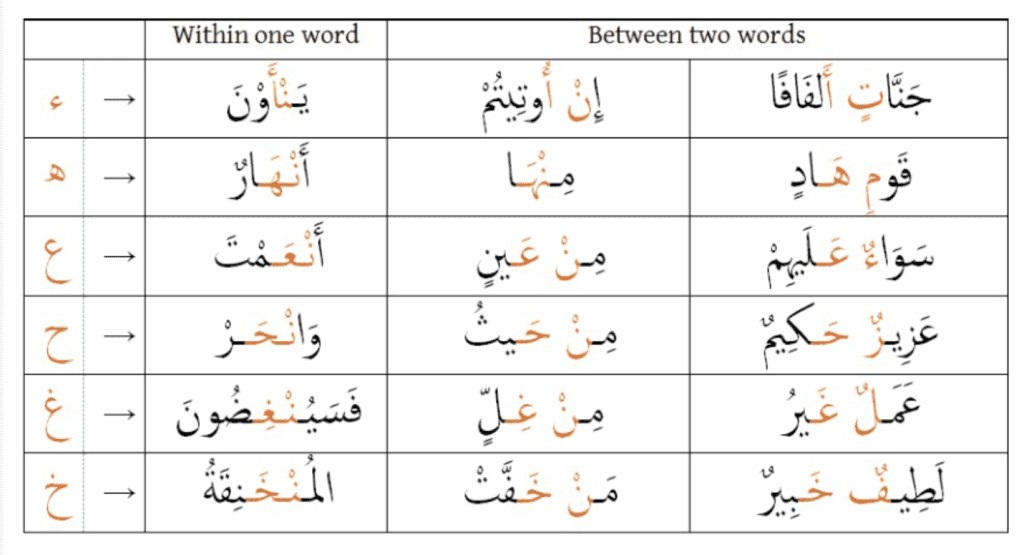Meaning of Tajweed
Tajweed is a familiar term for those who have learned to recite the Quran. The pure meaning of the word is ‘to perfect, to beautify, or to improve’. In Islam, it is a set of rules to help readers recite the Quran in the same way that Prophet Muhammad (pbuh) learned from Jibreel.
Importance
Not only does it beautify the recitation, but learning Tajweed also ensures the message is not distorted by mistake. Reciting without Tajweed could change the meaning of words as there are rules set in place to differentiate similar letters. Even incorrect elongations can alter the meaning.
Benefits
There are many benefits to reading the Quran. Here is a hadith specifically illustrating the reward of reciting beautifully narrated by A’ishah, may Allah be pleased with her:“One who recites the Quran beautifully, smoothly, and precisely will be in the company of noble angels. As for the one who recites it with difficulty, stammering or stumbling through its verses, (s)he will have twice that reward.” [Al-Bukhari]
Even beginners are rewarded when struggling to recite correctly! Learning how to recite beautifully also gives the added benefit of wanting to recite the Quran more frequently as it sounds pleasant to the ears. Most importantly, Allah will take note of the effort and time that his servant put in to recite His words even if they never obtain perfection.
Learning Tajweed
It is recommended that one learns Tajweed from someone that has mastered it, as they can guide the student to learn each rule. It is difficult to hear one’s own mistakes when reciting, so reciting to a teacher helps greatly.One can still practice by themselves by recording the section they recite and listening to it alongside a professional reciter of the Quran (such as Sh. Mahmoud Khalil al-Husary, Mohammed Ayoub, or Mishary Alafasy). Anytime you want to practice or follow along, listening to professional reciters can help teach the correct pronunciation of letters and proper Tajweed rules.
One can seek out classes at a local mosque or enroll in an online course, such as Quranic’s Tajweed course, which helps students learn efficiently at their own pace through recorded videos. YouTube also contains many courses teaching the Tajweed rules. Listening to correct pronunciation is key!
Tajweed Rules
Tajweed, from the onset, needs to be learned through hearing and practice to match the perfect recitation. The rules below are only here as a descriptor and one should seek out assistance. This article will only go through some of the more important rules at a broad level. One can use this as a guide as they learn the rules. Below are some definitions that will be used throughout the explanations:
Gunnah ( nasal sound)
This is the sound that comes out from your nose when pronouncing certain letters. Pinch your nose so that you are unable to breathe from it. Now try saying words that start with ‘m’ or ‘n’. You will feel your nose vibrate if you hold that letter. Like saying “Mmmm” when seeing tasty food!
Sakinah/Sakin:
This refers to a letter with sukoon.For example: noon sakinah refers to the letter noon with sukoon نْ
Noon Sakinah & Tanween
This Tajweed rule concerns the vowels and letters that create the ‘nnn‘ sound such as:
1.noon sakinah نْ
2.letters with tanween (a double vowel that adds the noon sound to the applied letter)
بًا (ban)بٍ (bin)بٌ (boon)
Idhaar (to make clear)
If noon sakinah نْ or a tanween is followed by these 6 letters [ء ه ع ح غ خ], then pronounce the noon normally (without ghunnah.)
[ ء ه ع ح غ خ ]

Idghaam (to merge)
There are two forms of Idghaam: one with ghunnah and one without.
1.With Ghunnah:
If these letters [ي ن م و] are followed after a noon sakinah or tanween, then skip the ghunnah from the noon, but instead apply the ghunnah with the followed letter.[ ي ن م و ]
(فمنْ يعمل)
(Surah Al-Zalzalah, 99:7)
2.Without Ghunnah:
If these letters [ل ر] are followed after a noon sakinah or tanween, then skip noon and pronounce the followed letter without ghunnah.[ ل ر ]
(هدًي مّنْ رَّبِّهم)
(Surah Al-Baqarah, 2:5)
Iqlaab (to convert)
If there is a [ب] followed after a noon sakinah or tanween, then turn the ghunnah into a [م] by pronouncing the meem, but still pronouncing the [ب] afterward.
فمنْ تابَ منْ بَعْدِ ظُلمِهِ
(Surah Al-Ma’idah, 5:39)
Ikhfaa (to hide)
Ikhfaa applies to the remaining letters not mentioned [ ت ث ج د ذ س ش ص ض ط ظ ف ق ك ]. One should hide the noon sakinah or tanween but apply ghunnah. The level of ghunnah depends on the specific letter that is followed after. Adjust the lips and mouth as if you are about to pronounce the letter after the noon sakinah or tanween.
[ ت ث ج د ذ س ش ص ض ط ظ ف ق ك ]
Noon & Meem Mushaddad
This is a simple Tajweed rule that only applies to two letters.
If a noon or a meem has shaddah, then pronounce a 2 beat ghunnah. This is still applied when stopping on the letter. Careful not to extend the sound of the letter, but only the ghunnah.
ثُمَّ = thummma
إِنَّ = innna
Meem Sakinah
This Tajweed rule has the same sub-rulings as noon sakinah and tanween, but not as many specific letter applications.
Ikhfaa Shafawy
If a [ب] is followed after a meem sakinah, then apply a ghunnah while hiding the meem sakin before continuing to the [ب].
Idghaam Shafawy
If the start of the word begins with a meem and is followed with a meem sakinah, then merge the words through the meem and apply ghunnah.
Izhaar Shafawy
This sub-rule applies to the rest of the letters when they follow a meem sakinah. Simply pronounce the meem clearly without ghunnah and no merging to the next letter.
أَلَمْ تَرَ = Alam tara
Qalqalah
This Tajweed rule means ‘echoing’ and the application is to create an echoing sound at the end of the pronunciation of certain letters. The purpose of this rule is to differentiate between letters that have similar sounds when one stops on them (letter with sukoon, end of ayah, or taking a breath). It also helps create flow within the recitation.
The Qalqalah letters are as follows:
[ ق ط ب ج د ]
There are three places that the reciter needs to be wary of when performing Qalqalah.
When it occurs in the middle of a word, then it is a quick echo and a smooth continuation to the next letter. It is like a shaddah, but without the clear extension of the vowel.
تَجْرِي = tajeree
If one is stopping on a word that ends in Qalqalah, make the echoing a little more pronounced.
اللَّهُ الصَّمَدُ = Allahu samadda
If one is stopping on a word that has Qalqalah and it has a shaddah, one needs to have a jerking echo.
لَهَبٍ وَتَبَّ = lahabiuuu wa tabbbaa
Al-Madd
Madd affects letters which the reciter needs to stretch longer than they usually would. The elongation differs depending on the situation and the symbol present. The length of the Madd is usually described by the number of harakat or beats. Each different sub-rule has its name, but to keep things clear and concise they are grouped by the number of beats instead. The names of all of the rules are provided in one of the referenced links.
The madd letters are: [ ا و ى ]
Two Beat Madd
When one of the Madd letters is connected to another letter not followed by a hamza or letter with sukoon, then elongate it for only two beats. This is referred to as the natural Madd. If a hamza precedes a Madd letter, then the prolongation is still only 2 beats.
دِينُكُمْ = dee nukum
يَا = yaa
عَابِدُونَ = A’aa be doona
If one stops at a word that ends in a tanween fatha, turn the tanween into an alif Madd.
أَفْوَاجًا = Aff waa jaa
Flexible Madd (two, four, or six)
If one stops at a word in which there is a Madd before the last letter, then one can exaggerate the Madd to four or six beats. Two beats is still the minimum required here and one can do the elongation to four or six only if they stop at the word.
إِلَٰهِ النَّاسِ = ilaa hinnnaaaas
Four Beat Madd
If there is a Madd letter in the middle of a word and a hamza follows it, the Madd should be prolonged by four or five beats. Similarly, if the word ends in a Madd and the beginning of the next word starts with a hamza, then the Madd should again be prolonged by four or five beats.
إِذَا جَاءَ = idhaa jaaaa a
(Although both dhal and ja contain an alif Madd, ja is extended longer due to the hamza)
Six Beat Madd
If a letter with a shaddah follows a Madd letter, then the Madd letter should be prolonged for 6 beats.
وَلَا الضَّالِّينَ = wa laddaaaaaalleeen
If a letter with a sukoon follows after a Madd letter, then the Madd letter should be prolonged for 6 beats.
Takeaway
This article gives a summary of what Tajweed is and the benefits regarding it. There are still many nuances to Tajweed that were not explained in this discussion, so keep learning! Listening is one of the best ways to learn as that is how the Quran was originally spread. One can learn Tajweed without ever learning the names of the rules, by just having someone repeatedly correct their recitation. Allah has provided the ummah knowledge at their fingertips, so take advantage of this technological age!


